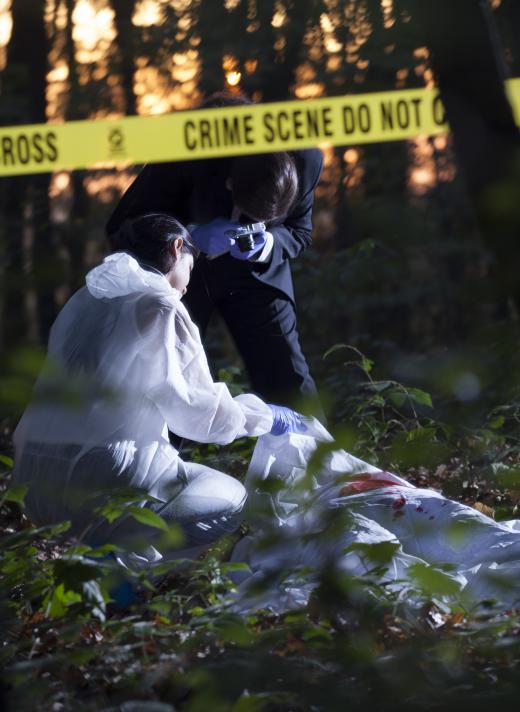What is Forensic Entomology?
 Mary McMahon
Mary McMahon
Forensic entomology is a field of science which uses insects to gather information about a crime scene. The discipline has been in existence for thousands of years, although forensic entomology was only integrated into Western science in the nineteenth century. Forensic entomology draws upon the principle that the life stages of insects follow a set pattern, and therefore insects found at a crime scene can yield information about the time and place of a person's death.
Forensic entomology is only one part of medical anthropology, which looks at a variety of specific elements at the scene of death to gain a deeper understanding of it. Medical anthropologists study everything from ancient burial sites to modern day crime scenes. Several universities around the world have programs to study and research medical anthropology in the hopes of improving criminal justice.

In the East, a long tradition accompanies forensic entomology. Some Buddhist monasteries encourage their monks to contemplate the dead in all stages of decay. Monks have written about insects at the scene of decay for thousands of years. In 1235 AD, a Chinese forensic investigator named Sung Tz'u wrote a book about crime scenes called The Washing Away of Wrongs. The text included references to forensic entomology, suggesting that it was included in Chinese investigative techniques.

Forensic entomology in the West has its roots in a series of experiments performed by Francesco Redi in the 17th century. He was curious about the colonization of rotting meat by insects, and set out samples of meat that were protected from insect invaders along with samples that were exposed. He discovered that the protected meat simply rotted, while the exposed meat was colonized by a series of insects, thus disproving the spontaneous generation theory. This theory had held that insects simply appeared in meat that was kept under the right conditions.
In 1855, forensic entomology was used again in the case of an infant corpse that had been found sealed inside a wall. The collection of insects around the body led investigators to believe that the body had been there for several years, which meant that current residents of the home were unlikely to be responsible for the crime. The value of the science was seen, and began to be more carefully studied.
Forensic entomology is a growing discipline, and many medical anthropologists make their services available to police departments who cannot invest in a forensic entomology program of their very own. Investigators collect samples of insects from the entire crime scene and body, attempting to collect a broad spectrum of insects for the most accurate results.
The two families of insects most commonly found at the scene of death are flies and beetles. Investigators look at the insects to determine how long they have been colonizing the body. Flies, for example, can be distinguished by generation. Maggots in the first stage, or instar, have probably only been on the site for a few days. Maggots in later instars indicate that the body has been dead for some time, because multiple generations of maggots have bred. The presence of beetles on the body indicates that an even longer period has passed.
By using knowledge about how long it takes insects to develop, along with weather conditions, scientists can make an estimation of time of death. Because flies mature at very set rates, scientists can often pin the time of death to a small window of only a few days. Forensic entomology has been used in many criminal cases to effectively prosecute criminals.
AS FEATURED ON:
AS FEATURED ON:












Discussion Comments
Sneakers41-The forensic entomology definition really illustrates how forensic entomology insects are used in order to solve crimes in which the body was highly decomposed.
Often the forensic DNA in these cases are severely degraded and affected by the elements of sun, rain and other outdoor conditions.
Sometimes forensic anthropology becomes important because the there is no tissue left at the crime scene.
In forensic anthropology, a study of the skeletal remains is done in order to identify the victim and the cause of death.
If there is slight tissue remaining then that remaining tissue might be sent in order to perform forensic toxicology tests in order to determine what chemicals were found in the body. Once the body is reduced to skeletal remains, the toxicology tests can not be done.
Forensic entomology cases are often assisted through the analysis of the insects found on the body.
The type of insect that is found on the body can discern a lot. For example, if insects found on the body are usually insects found in remote areas unrelated to where the body was found can give forensic analysis that shows that the body was moved.
Also, if a suspect was bitten by an insect that could only be found in certain areas also puts the suspect potentially at the crime scene. The blood sample is sent to a forensic entomology lab in order to confirm the species of insect.
Post your comments